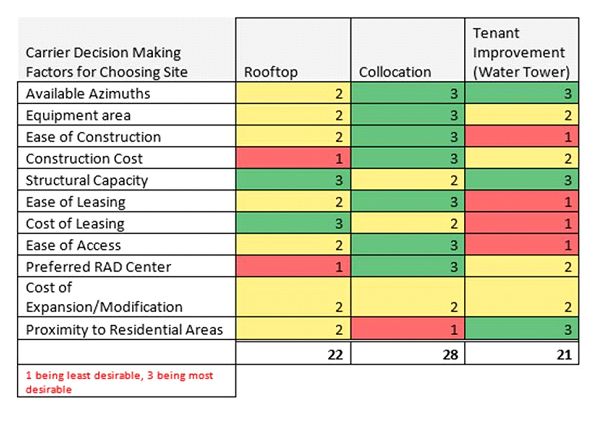Cell Site Selection Priorities by Wireless Carriers
A common question we get at Steel in the Air: Do wireless carriers prefer to collocate their cell sites on towers, to install the cell sites on rooftops, or to use existing structures like water towers? One of our municipal clients asked the same question and to help them, we put together the chart below. The chart BELOW illustrates the pros and cons of different types of structures that might be used by a wireless carrier. Tenant improvements are defined as structures that were not originally designed for communication antenna installation but are adapted for such a purpose. They include billboards, water towers, signs, and light poles. The chart uses a grading scale of 1 to 3, with 1 being the least favorable to the carrier and 3 being the most favorable.
Here is a summary of the site characteristics:
- Available Azimuths – Azimuths are antenna headings, based on compass divisions totaling of 360 degrees. The ideal situation for the carrier is to be able to choose their antenna azimuths at will without limitation due to the type of structure.
- Equipment Area – This is the lease area where the transmission equipment (like a base station or generator) is placed. The carriers prefer larger area for their equipment.
- Ease of Construction – How easy or difficult it is for contractors to access and work on the equipment. The carriers prefer lower costs and easier construction.
- Construction Cost – Cost to physically install the equipment as well as engineering costs and permitting or zoning costs.
- Structural Capacity – Ability of the structure to support the wireless carrier’s equipment as well as reserve capacity of the structure that may allow for future equipment without costly upgrades to the structure itself.
- Ease of Leasing – Ease with which a lease can be negotiated with the owner of the structure and the time it takes from starting negotiations to signing the lease. The ease of leasing is typically a reflection of the overall number of structures that the structure owner has- with tower companies just having a much easier process.
- Cost of Leasing – Overall monthly rent of leases for the specific structure.
- Ease of Access – How readily available the site equipment is for wireless carrier technicians or sub-contractors to access. The carriers prefer having 24/7 access without having to contact anyone for prior confirmation.
- Preferred RAD Center – RAD center is the height of the antennas (center of radiation) on the structure. The carriers prefer to mount their equipment at the exact height they want. Buildings and water towers have greater limitations on terms of available heights than specifically designed tower structures.
- Cost of Expansion/ Modification – Average cost burden if modifications are necessary to the structure for equipment upgrades or the average market value of expanded equipment leases. Buildings and water towers are typically built to support sufficiently greater overall weight and adding further antennas is rarely an issue. However, many towers (especially those built in the 1990s) need structural modifications in order to accommodate additional loading of larger/more antennas.
- Proximity to Residential Areas – Sites closer to residential areas are more valuable than remote sites or industrial areas due to customer demand and zoning restrictions. This factor is a reflection that oftentimes new towers aren’t allowed in residential areas and as such existing buildings and water towers are more desirable.
In reviewing the final “tally”, collocation on towers is the preferred option for wireless carriers in most situations. Only if there isn’t a tower available will the carrier start to seek other options like rooftops or tenant improvements on non-tower structures. Installation on rooftops and installation on non-tower structures are fairly similar in terms of preference to the wireless carrier. However, as mentioned above, there may not be any other options especially in residential areas or dense urban areas in which case the wireless carriers will seek to use rooftops or tenant improvements.
As to whether the carrier will choose a rooftop or a tenant improvement often comes down to who owns the structure or building. In general wireless carriers prefer to lease from small private property owners and building owners. The lease process typically takes less time and private landowner or structure owners are unlikely to know the fair market value of their site or have a good attorney who will add the appropriate protections to the lease.

